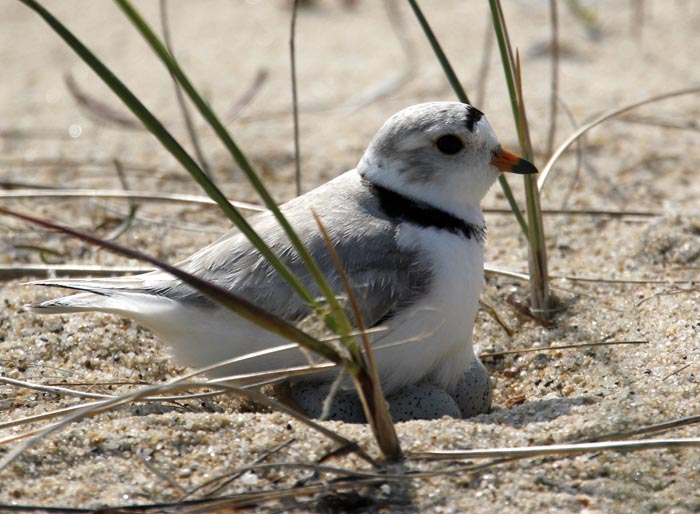About midday yesterday, the lady bather was treading her way carefully through the dunes, ducking as a small group of avian aggressors swooped around her, piping angrily. Only when she finally plunged into the sea did they break off the attack.
About 100 feet away, Caitlin Borck was encouraged.
It’s not that she enjoys seeing other people get swooped, or likes getting swooped herself — and occasionally, deliberately, unerringly excreted upon — by the little birds.
It’s just that as a shorebird expert she knows that such an attack could only mean that somewhere up among the dune plants, there were least tern eggs or chicks.
And that is heartening to Ms. Borck, the coastal waterbird and citizen science coordinator at Mass Audubon’s Felix Neck Wildlife Sanctuary, for this has not been a good year for the several species of shorebirds whose breeding she is monitoring.
With her colleagues and volunteers she is watching over 16 sites in all: eight with piping plovers, seven with least terns, two with common terns and nine with oystercatchers. Two or more species coexisted at some sites.
So far they have produced just six fledged offspring between them, three piping plovers and three oystercatchers.
There will certainly be more — there are a dozen or more chicks which have yet to fledge — but this late in the season, it is not a good result. “It’s been kind of a bad year, for a number of reasons,” Ms. Borck said.
“The [spring] weather wasn’t very good, with all the northeasters. So they got started late. Some nests got washed out, early on. And there have been a lot of predation problems.”
Skunks present a particular threat to eggs, as gulls and crows do to the chicks. Then there are dogs, rats, vehicles and human feet.
“At one site they’re on their third nesting attempt. They will keep renesting until about now,” said Ms. Borck.
The little birds have their varying means of defense: swooping and pooping for the least terns; the broken-wing routine of piping plovers to draw predators away from nests; more aggressive swooping by common terns, which have been known to inflict injuries requiring stitches.
But their nesting practices, making simple scrapes in the sand on exposed sandy shoreline, make them very vulnerable.
Common terns are not common at all, but a species of special concern in Massachusetts. Piping plovers and least terns are listed as threatened, and oystercatchers as a species of concern.
And so experts like Ms. Borck, along with their amateur helpers, monitor the populations every year. She said she did the rounds every couple of days, checking for new nests and broods, noting signs of predators, weather and wind conditions and all the other variables which could impact the birds’ chances of survival.
“And I go more often if it looks like eggs are about to hatch or there are chicks we are concerned about,” she said.
There are protocols governing monitoring visits: They don’t go if the temperature is too hot or cold, or the wind too strong. She explained why.
“If you disturb the adults on a hot day, in 15 or 20 minutes unattended, an egg can get cooked.”
Various methods are used to try to improve the chicks’ chances of survival. For the most part this means simply roping off nesting areas, warning people not to go there.
“Usually we fence to the high tide line or the dune line, so as to leave people a walking path,” Ms. Borck said.
But sometimes it takes more determined means. Thus Tashmoo Beach was closed in mid-May to protect a nesting pair of plovers, who had chosen the parking lot at the end of Herring Creek Road to raise their family. It has been reopened.
“We were worried about adult mortality, they were running in front of vehicles,” she said.
Alas it came to naught. Six hatched but one by one, the chicks were picked off by predators within a couple of days.
Over recent years, it has become a common practice to build what are known as exclosures — structures designed to keep predators out, around plover nests.
But this year, that strategy is being reassessed
Sometimes the structures may lead to the abandonment of nests.
“And especially on the mainland, there have been some problems with adult mortality. So they’re reassessing how often they want to exclose, because there are risks that go along with it,” Ms. Borck said.
Here on the Island, two exclosed nests were abandoned early in the season, although whether this was due to the structures or to bad weather is uncertain.
“We put up exclosures around nests that are well–established, where the adults are really attentive and defensive and there’s little chance of them abandoning, Ms. Borck said.
The director of Felix Neck, Suzan Bellincampi, said there was some concern too, that some predators had learned to see exclosures as targets.
A review of data from last year had shown plover survival rates were about the same whether their nests were exclosed or not.
And so the science of protecting these vulnerable little birds continues to evolve, informed by the observations of the likes of Ms. Borck, Ms. Bellincampi and others. And the failures teach as much as the successes.
“It’s like plover CSI,” said Ms. Bellincampi.






Comments
Comment policy »